Beautiful Plants For Your Interior
How to Easily Grow Dahlias From Seed: A UK Gardener’s Guide
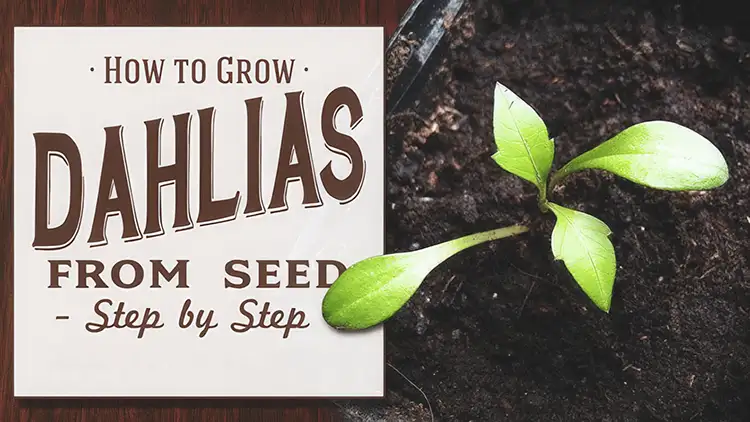
How to grow dahlias from seed is an exciting process that this post will guide you through, although many gardeners grow dahlias from tubers.
Welcome to the colourful and rewarding world of dahlias! These spectacular flowers, with their incredible range of colours, shapes, and sizes, are a firm favourite in many UK gardens
For a quick start, you’ll need your seeds, some peat-free compost, and a warm spot to get things going. Heat mats can boost germination, but aren’t always essential. Don’t forget to keep your seedlings well-lit once they emerge.
If you’d like to get the best results, I’ve packed this post with everything I’ve learned about planting and nurturing your dahlia seedlings. So, why not carry on reading, and I’ll walk you through it step-by-step and you will be enjoying your gorgeous homegrown dahlias in no time!
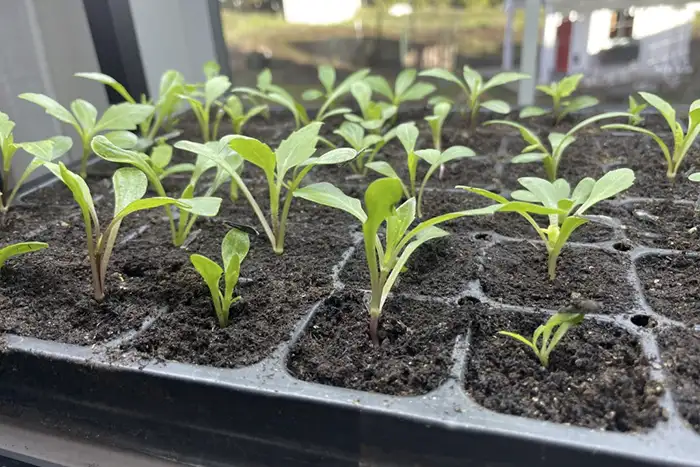
Growing Dahlias From Seed: Dahlias grown from seed is not as daunting as you may think.
Growing Dahlias from seed is a cost-effective way to get lots of plants, enjoy a delightful surprise when they bloom, and even create your own unique varieties. Dahlias also attract valuable pollinators to your garden, and their open-centred flowers are particularly attractive to bees.
You can get started in late winter or early spring by sowing indoors, or you could try direct sowing once the weather warms up. I know it might sound daunting but it’s actually quite straightforward
Growing dahlias from seed offers several compelling advantages:
- Cost-Effective: Seeds are considerably cheaper than tubers, making it a budget-friendly way to fill your garden with these stunning blooms.
- The Joy of Surprise: Unlike tubers that produce clones, each dahlia grown from seed will be unique, offering the potential for different colours, shapes, and sizes. It’s like unwrapping a surprise gift with each bloom.
- A Great Learning Experience: Growing from seed allows you to understand the life cycle of dahlias more intimately.
- Bee-Friendly Flowers: Dahlias with open-centred flowers are particularly attractive to bees and other pollinators, enhancing your garden’s biodiversity.
- Annual Growing: Dahlias grown from seed can be treated as annuals, making them suitable for a variety of gardening styles.
- Potential for New Varieties: By growing from seed you have the opportunity to create entirely new dahlia varieties.
Growing dahlias from seed is a journey of endless possibilities, full of delightful surprises.
Understanding the Difference Between Seeds and Tubers
It’s important to understand that dahlia seeds will not produce exact copies of their parent plant. Each seed is genetically unique, leading to variations in the resulting flowers.
On the other hand, dahlia tubers will produce identical plants to their parent, guaranteeing specific colours and forms. If you are after a specific variety, then tubers are the way to go, however, growing from seed allows for the chance of discovering something completely new.
When to Sow Dahlia Seeds in the UK
Timing is key for successful dahlia cultivation in the UK. It’s generally recommended that you start seeds indoors in late winter or early spring, typically from February to April. This timing allows you to get a head start on the growing season, approximately 6 to 8 weeks before the last expected frost.
You can also sow directly outdoors in late spring when the nights are consistently above 10°C (50°F). However, it’s essential to know your local frost dates to avoid any setbacks.
UK Last Expected Frost Dates
| Region | Last Expected Frost Date |
|---|---|
| South East England | Mid-March to Late April |
| South West England | Late March to Early May |
| East Anglia | Late March to Mid-April |
| Midlands | Mid-April to Early May |
| North West England | Late March to Mid-April |
| North East England | Early April to Late April |
| Yorkshire and the Humber | Mid-April to Early May |
| Wales | Late March to Early May |
| Scotland | Late April to Early June (varies greatly depending on location) |
| Northern Ireland | Late March to Mid-April |
Checkout our plant ‘Hardness Zones‘ for your area.
What You’ll Need: Getting Prepared
Before you begin, ensure you have the following materials ready:
- Dahlia seeds.
- Seed trays or small pots.
- Multi-purpose, peat-free compost.
- A propagator or clear polythene bags (optional – see seed trays above).
- Labels and a pencil.
- Heat mat (optional but recommended).
- Indoor grow lights.
- Seed starting mix or soilless potting mix.
- Vermiculite (optional).
How to Sow Dahlia Seeds: A Step-by-Step Guide
Follow these steps to sow your dahlia seeds successfully:
- Fill your pots or seed trays with moist compost and gently firm the surface.
- Gently push the dahlia seeds into the compost, about 5mm (0.5cm) deep. Don’t sow too deeply.
- Don’t forget to label your seeds!
- Cover with a clear plastic bag or propagator lid.
- Place them in a warm location, ideally between 18°C and 21°C (64-70°F). A heat mat can significantly improve germination rates.
- Keep the compost moist but not soggy.
- Seedlings should appear within 10 to 14 days, although it can sometimes take up to two weeks. Some growers have had success with germination in less than three days with the use of heat mats.
- Once germinated, move the trays under grow lights to ensure strong growth.
- It is a good idea to plant more seeds than you will need, in case some don’t germinate.
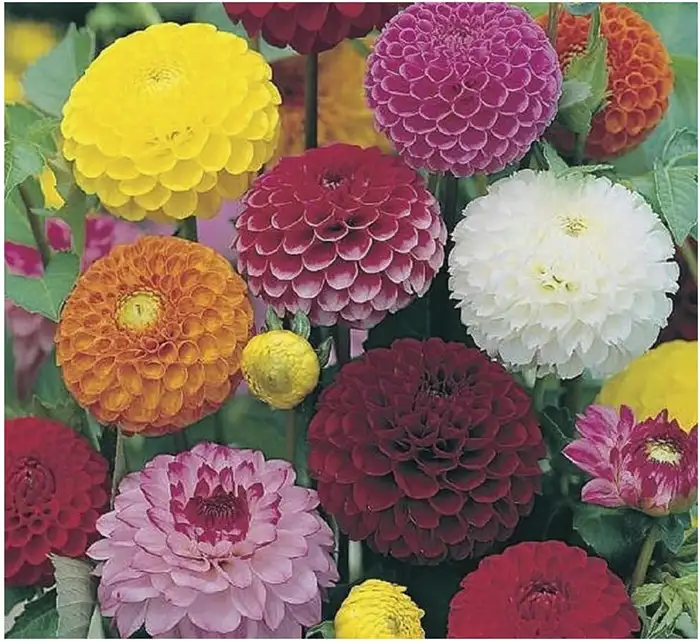
How to Grow Dahlias From Seed: ‘Pompone Double Mix‘ dahlias give height and structure to the back of your borders
Caring for Dahlia Seedlings: Nurturing the Newcomers
Once your seedlings have germinated, here’s how to care for them:
- Remove from heat mats after germination, as they prefer slightly cooler temperatures.
- Ensure good ventilation to prevent fungal diseases. A small fan can be helpful to circulate air if ventilation is poor.
- Water from the bottom regularly, keeping the growing medium moist but not soggy.
- Provide plenty of light: 14-16 hours daily under grow lights.
- Begin feeding regularly with a diluted, balanced, water-soluble fertiliser once they have their first set of true leaves.
Potting On: Giving Seedlings More Room
As your seedlings grow, they will need to be moved into larger pots. Check for roots emerging from the bottom of the pot, or if the plant is getting too large for its current container. Be gentle when teasing them out of their old pots to avoid damage.
Tip: I always water’ my young plants an hour or so before ‘potting on’ as it makes them easier to remove from their existing pot.
Hardening Off: Preparing for the Great Outdoors
Before planting your dahlias in the garden, they need to be acclimatised to outdoor conditions. This process is called ‘hardening off.’ Start by placing them outside for a few hours each day in a protected, shady location. Gradually increase their time outside, and bring them back indoors at night for a week or two.
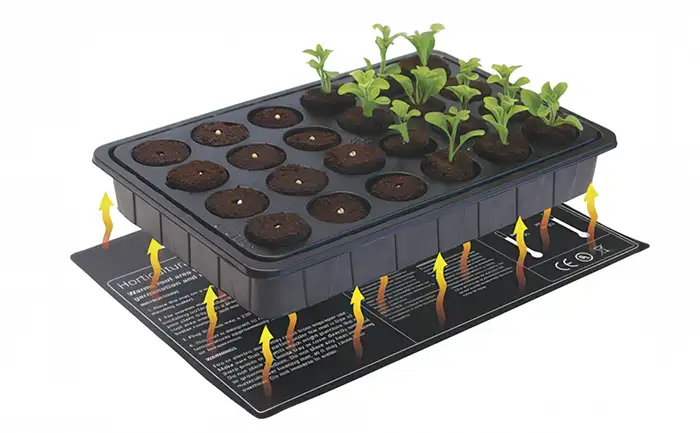
How to Grow Dahlias From Seed: Seeds benefit from the use of a ‘heat mat’ as it provides faster seed germination, but it’s not essential.
Planting Out: Settling into the Garden
Once the risk of frost has passed, usually in late May or June in the UK, you can plant your dahlias in the garden. Choose a sunny spot with well-draining soil. Enrich the soil with plenty of compost or well-rotted manure.
Space them about 30-45cm (12-18 inches) apart in borders, or closer at about 30cm (12″) in dedicated beds. Plant them at the same depth they were growing in the pot, and water them gently.
Ongoing Care: Keeping Dahlias Happy
Throughout the growing season, your dahlias will need some ongoing care:
- Watering: Water regularly, especially in dry weather, aiming for around 2.5cm (1 inch) of water per week, sometimes 5cm (2 inches) in hotter weather. Focus on watering at the base of the plant.
- Mulching: Apply mulch around the base of your plants to conserve moisture, keep weeds down, and keep the soil cool.
- Fertilising: Feed with a balanced liquid fertiliser when buds appear and regularly (follow the manufacturer’s instructions) throughout the flowering season.
- Staking: Provide sturdy stakes to support the delicate, hollow stems. Dahlias grow quickly and can easily break in wind or rain.
- Deadheading: Regularly deadhead spent flowers to encourage continuous blooming.
- Pest Control: Keep an eye out for pests, and take appropriate action if needed.
Overwintering Dahlias Grown From Seed
Dahlias grown from seed will produce tubers by the end of the growing season. These tubers may be smaller in their first year. You have two options for overwintering:
- Dig Up Tubers: In the autumn, after the first frost has blackened the foliage, dig up the tubers. Clean them gently, let them dry, and store them in a cool, dry place, such as a Ziploc bag with peat moss, wood shavings or vermiculite. The storage area should not freeze, ideally between 4°C and 10°C (40°F and 50°F).
- Leave in the Ground: In milder areas of the UK, you can leave the tubers in the ground with a good layer of mulch over the top for protection. Clear away the mulch in the spring once the worst of the frosts are over.
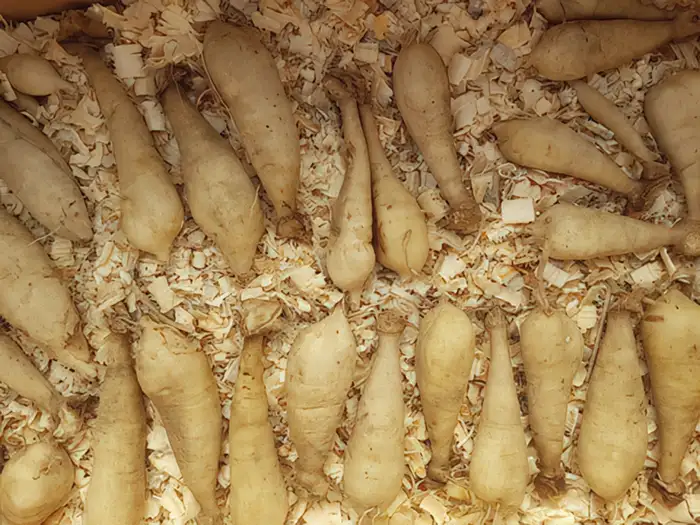
How to Grow Dahlias From Seed: Digging up tubers for winter storage? Wood shavings is a good ‘storage’ medium for ‘overwintering’ Dahlia tubers.
Saving Dahlia Seeds: The Next Generation
If you want to save seeds from your dahlias, here’s how:
- Allow some flowers to set seed by not deadheading them.
- Collect the seed at the end of September or when the flower head is dry.
- Dry the seeds out and save them in an envelope over winter.
- The seeds are found inside the dead, dry flower heads.
Troubleshooting: Dealing with Problems
Here are some common issues and their solutions:
- Yellowing Leaves: This could be a sign of overwatering or nutrient deficiency. Ensure good drainage and give your plants a diluted feed if needed.
- Leggy Plants: Leggy plants can indicate insufficient light. Make sure they have enough light, and consider using grow lights if needed. You can also pinch off the stem to encourage branching.
- No Flowers in First Year: It is not uncommon for dahlias grown from seed not to flower in their first year. They will usually produce tubers though, and will flower the following year.
- Low Germination Rate: A germination rate of between 30-75% is normal for dahlia seeds.
Recommended Dahlia Varieties for the UK
Some good seed varieties for UK gardens include:
- “Bishop’s Children“.
- Dwarf or bedding types such as ‘Figaro‘, ‘Rigoletto‘, ‘Coltness Gem‘.
- Varieties with good cut flower potential.
- Varieties with dark foliage such as ‘Redskin’.
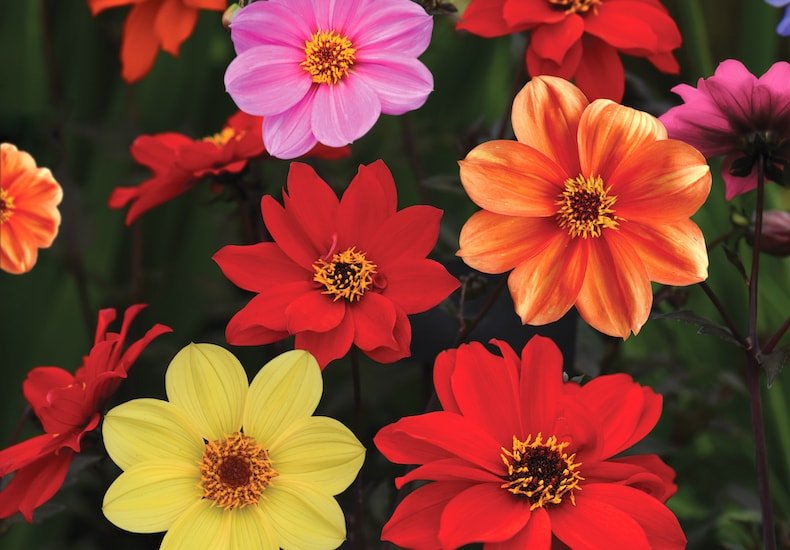
Growing Dahlias From Seed: ‘Bishops Children’ Open Centre Mixed
Conclusion
Growing dahlias from seed is a rewarding and exciting experience. It is a fantastic way to get more plants, a greater variety of colours and flower shapes and to discover something new and beautiful. Don’t hesitate to give it a try and enjoy the wonderful, colourful results!
For further resources, you may want to research local gardening groups and online communities for information relevant to your specific location.
FAQ’s Growing Dahlias from Seed
What is the best soil for dahlias?
Rich, fertile, well-draining soil is ideal.
Can I plant Dahlias in a container?
Yes, but choose shorter or dwarf varieties.
Are dahlias good for bees?
Yes, especially single varieties with open centres.
When should I remove humidity domes from my seedlings?
Remove the humidity domes when about 50-60% of the seeds have germinated to avoid mould or fungus issues.
What do I do if my seedlings get leggy?
If your dahlia seedlings are getting leggy, ensure they are getting adequate light. You can also pinch the stem above a leaf node to encourage branching. You may need to pot them up into bigger pots.
How far apart should I space dahlia plants?
When planting in garden beds, allow for a spacing of 30-45cm (12-18 inches) between plants. Seedlings can be grown closer together (around 10cm or 4 inches), particularly if you are breeding, or are planning to lift and divide tubers later. If you are planting in rows, aim for 30cm (12 inches) between rows.
These FAQs should give you a great starting point for growing dahlias from seed. Remember, gardening can be a bit of a treasure hunt, so embrace the surprises and enjoy the process!
